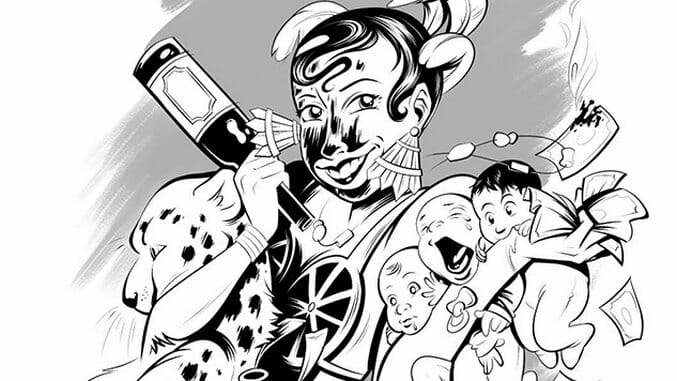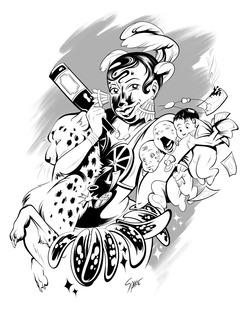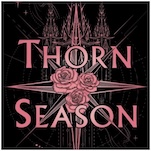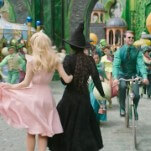DIY Comics Queen Spike Trotman: The Best of What’s Next

Even as a child, Charlie “Spike” Trotman defied convention. An outspoken thought leader in underground comics today, the cartoonist stood her ground in her hometown of Potomac, Maryland, before cultivating a new one in the publishing industry.
“I got into a lot of fights! Verbally, physically,” Trotman explains. “I was a scrappy little kid. I’m just contrarian by nature, honestly. Always have been. I’ve just expressed it in different ways the older I get.”
Since her ornery youth, Trotman has gone from tracing The Far Side and Calvin and Hobbes Sunday strips to establishing a DIY comics refuge in Iron Circus, the indie publishing company she runs out of her Chicago residence. Founding the imprint in 2005, the cartoonist has devoted her pen to pushing the boundaries of comics for the entrepreneurial and unconventional, crafting charming manuals on how to launch successful Kickstarter campaigns and guides on thriving off marginal resources (the latter of which, appropriately, was her first successful Kickstarter campaign in 2009). Templar, Arizona, a buoyant webcomic with a diverse set of characters, ran from 2005 to 2014.
In an industry where two companies—Marvel and DC—hold almost 80 percent of the comic store market, innovators like Trotman are progressively seeking to expand the sequential art pie to underserved readers through new venues, including book stores and the digital marketplace. “Aside from a big, big spike in the ‘90s that crashed right back down after Marvel filed for bankruptcy, comic book readership has been falling for decades,” Trotman says. “There are many, many factors involved in that. The primary one is that comics has been content to sell to the same gender and the same age group for that entire time. I think mainstream, when referring to Marvel and DC, is going to become more and more of a misnomer.”
Two new projects will punctuate that future-forward agenda: a new entry in Trotman’s female-friendly porn staple, Smut Peddler, and the biographical Black Pearl: The Graphic Life of Josephine Baker for publisher First Second.![]()
“I like dirty drawings. I think most people do,” Trotman says. “All throughout history, humanity has really liked dirty drawings. And I like comics. So it’s only natural I’d like dirty comics, but it was an event when I found a dirty comic that I could read and enjoy, and it wouldn’t end or climax (sorry) in a way that left me cold and feeling alien or grossed-out or unwelcome.”
That comic happened to be Smut Peddler, an infrequent anthology released by micro publisher Saucy Goose Press. After “harassing” their editorial staff at conventions to continue production, Trotman inherited the project, reintroducing the series in 2012 via a Kickstarter campaign with a creative lineup exclusively composed of women. And, much to her surprise, support swelled. “I wanted to say I had $300 in my bank account, because I’d been paying page rates out of pocket as stuff appeared. The goal was $20,000, and I remember thinking as I launched the project, oh, wouldn’t it be awesome if it made $40,000. And it ended up making $80,000. I knew it was good, but I didn’t expect other people to understand it was good.”

Yes, Roya Cover Art by Kinomatica
With collaborators including Carla Speed McNeil, Erika Moen and a cover by Emily Carroll, Smut Peddler melds graphic sex between all genders and humanoid species with emotional storytelling. The primary throbbing organ behind the project has remained its heart, without a mustached TV repairman or gym trainer in sight. The following year’s edition—which was the most successful project on Kickstarter for a day, earning $180,000-plus during its run—features tales of warring fantasy clans and stranded spacemen falling in fevered passion from creators including Joanna Estep and Jess Fink.
“Part of the reason I liked the original Smut Peddler so much is that it meant I could read a porno that wasn’t incredibly distasteful—I wouldn’t be ambushed by misogyny, which was something that was unfortunately really common when I read porn by guys,” Trotman says.
-

-

-

-

-

-

-

-

-

-

-

-

-

-

-

-

-

-

-

-

-

-

-

-

-

-

-

-

-

-

-

-

-

-

-

-

-

-

-

-










































